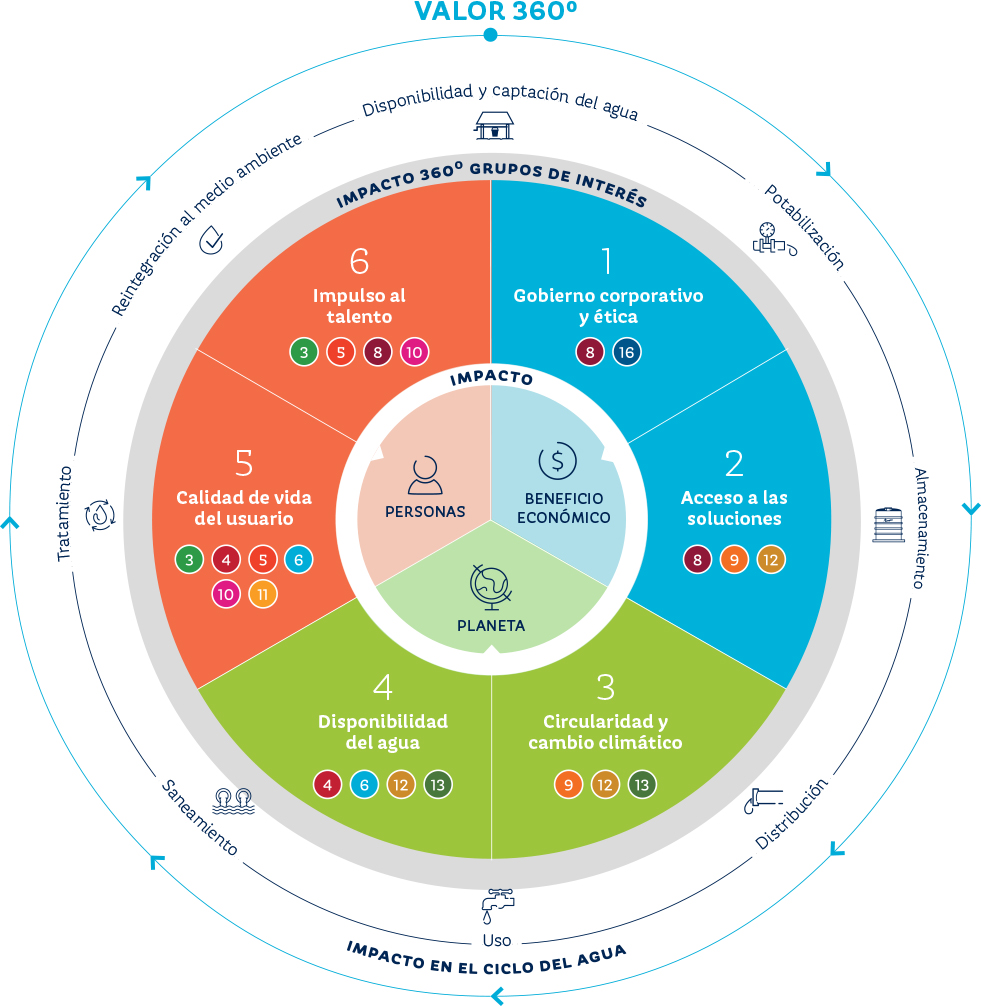
Sustentabilidad
Buscamos adoptar las mejores prácticas ambientales, sociales y de gobernanza a nivel global en nuestras operaciones diarias.
En Rotoplas, somos aliados de nuestros clientes para un uso más responsable del agua, ayudándolos a disminuir su impacto ambiental.
La sustentabilidad es fundamental en el Estilo de Rotoplas, formando parte de nuestro ADN y definiendo nuestra forma de operar. Nuestra Estrategia de Sustentabilidad adopta un enfoque 360°, en el que se consideran todos los grupos de interés a lo largo del ciclo del agua. Estamos comprometidos a maximizar los efectos positivos y reducir nuestra huella ambiental.

Estrategia de
Sustentabilidad

Documentos de
Interés

Políticas



Líneas de acción y Contribución a ODS
Indicadores clave de Rotoplas
Impacto 360° Grupos de Interés
1
- Fortaleza de la estructura y funcionamiento
- Cultura de ética y cumplimiento
- Integridad en la cadena de valor
2
- Digitalización y omnicanalidad
- Desarrollo de distribuidores y plomeros
3
- Gestión con enfoque de ciclo de vida
- Aprovisionamiento sostenible
- Eficiencia operacional
- Compromiso climático
4
- Huella ambiental de cliente
- Cultura del agua
- Participación de la agenda pública
5
- Experiencia del usuario
- Alianzas para el acceso
- Avance social
6
- Diversidad, igualdad e inclusión
- Crecimiento
- Seguridad, salud y bienestar
3
- Salud y bienestar
4
- Educación de calidad
5
- Igualdad de género
6
- Agua y saneamiento
8
- Trabajo decente y crecimiento económico
9
- Industria, innovación e infraestructura
10
- Reducción de las desigualdades
12
- Producción y consumo responsables
13
- Acción por el clima
16
- Paz, justicia e instituciones sólidas
Emisiones A1 y A2
(tCO2e)
Intensidad de emisiones
(tCO2e/t resina y material procesado)
Número de colaboradores
Porcentaje de mujeres en la plantilla laboral
Agua purificada
(Datos acumulados desde el 2016)
(millones de litros de agua purificada para consumo)
Agua residual tratada terceros
(Datos acumulados desde el 2016)
(millones de litros)
Independencia del Consejo
Diversidad en el consejo
(Porcentaje de mujeres)


Documentos de interés

Política de Integridad, Anticorrupción y Prevención del Conflicto de Intereses
Nuestra política busca dictar los lineamientos para ejercer actividades operativas y administrativas con apego a los principios de las leyes y regulaciones globales en materia de anticorrupción.
Ver políticaPolítica de Higiene, Seguridad y Ambiente
Estamos conscientes del entorno en el que operamos, incluyendo el agua, el suelo y los recursos naturales. Por ello, nuestra política ambiental busca proponer lineamientos integrales en estos rubros.
Política de Sustentabilidad
Es la integración de las metas organizacionales para la creación y distribución de valor económico, social y ambiental de Rotoplas para con la empresa y sus grupos de interés, que asegure los beneficios presentes sin comprometer la capacidad de generar y distribuir resultados para las generaciones futuras. La política se muestra a través del decálogo de sustentabilidad.
Procedimientos


Gobierno Corporativo
Estamos comprometidos con la generación de valor para nuestros grupos de interés en línea con nuestros valores y apegados al Estilo Rotoplas. En base a ello, seguimos los más altos estándares de gobierno corporativo, fortaleciendo la debida diligencia en el proceso de toma de decisiones.
Política de Derechos Humanos
Establece los principios y lineamientos necesarios para promover y respetar los derechos humanos de las personas relacionadas con las operaciones de Grupo Rotoplas, independientemente de su relación laboral con la compañía, así como la no discriminación en los procesos de contratación del grupo a fin de colaborar en la creación y distribución de valor económico, social y ambiental.


Política de Compras Sustentables
Tiene el objetivo de establecer los requerimientos en materia ambiental, social y de gobierno corporativo (ESG, por sus siglas en inglés) para los proveedores que integran la cadena de suministro de Grupo Rotoplas, con el fin de promover las mejores prácticas y un desempeño alineado con nuestros valores, entre los que se incluye la Responsabilidad social y ambiental.
Procedimientos
Política de Relaciones Institucionales
A través de la presente política, buscamos sentar las bases para desarrollar una red sólida de relacionamiento con los actores clave de nuestros Grupos de Interés (GI), con el propósito de favorecer el adecuado desarrollo de los negocios, una gestión proactiva de los riesgos y oportunidades, contribuir al desarrollo sostenible del entorno y consolidar la reputación de la compañía. Trabajamos en el planteamiento de relaciones con nuestros GI que estén sustentadas en el beneficio mutuo, buscando entregar valor para el conjunto de los mismos, aplicando una escucha permanente y la transparencia sobre nuestro desempeño.
Procedimientos


Política Anticorrupción
Establece los principios y lineamientos necesarios en materia de prácticas anticorrupción, incluyendo la prevención y actuación sobre el soborno, la extorsión, el fraude en la contabilidad, los conflictos de interés y cualquier práctica relacionada que suponga un incumplimiento de la legislación, por parte de colaboradores de Grupo Rotoplas y terceros actuando en nombre de la compañía.
Procedimientos
Política de Cambio Climático
Establece la posición de Grupo Rotoplas respecto al cambio climático, incluyendo los lineamientos para reducir la contribución desde los procesos operativos de la compañía y en su cadena de valor, así como la maximización del aporte que las soluciones desarrolladas tienen para la adaptación de los usuarios a los efectos climáticos sobre el abastecimiento y calidad del agua.


Política de Diversidad
Promover la equidad de trato, el respeto a la diversidad y la convivencia, así como la inclusión de aquellos colectivos en situación de vulnerabilidad. Guía la forma en que procedemos durante la selección e incorporación de nuevos colaboradores, la promoción interna, la entrega de remuneraciones y beneficios, y la relación diaria al interior de los equipos. Buscamos asimismo reconocer la diversidad como una fortaleza para la compañía, que permite atraer nuevas ideas y perspectivas.


